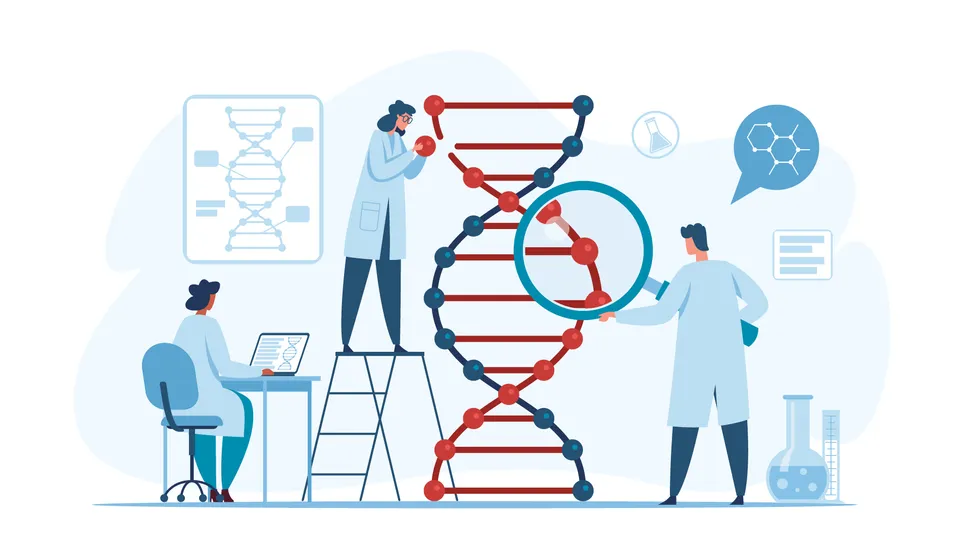The Bodily Mechanisms That Can Lead to Myelofibrosis

Most people living with myelofibrosis have heard about JAK2 and JAK2 mutations, but what exactly is JAK2, and how do these mutations play a role in developing the disease? Here, we try to break down a very complex biological process to help you understand how our bodies work.
Myeloproliferative neoplasms are types of blood cancer that begin with an abnormal mutation in a stem cell in the bone marrow. The change leads to an overproduction of white cells, red cells, and platelets. Stem cells are defined by their potential to develop into many different types of cells. In addition, they can replicate themselves. Stem cells are in almost all tissues of the body. They are critical for the maintenance of tissue and repair after injury. Thus, a stem-cell mutation can have serious consequences.
Continue reading about the causes of myelofibrosis: 'Why Do I Have Myelofibrosis?'
JAK2: A Key Element in the Disease Process
In 1951, a researcher first proposed an “undiscovered stimulus” causing the overproduction of bone marrow cells and leading to myeloproliferative neoplasms (MPN). Subsequently, in a sweeping effort to find kinases (a type of protein enzyme) that prompt cell growth and development, Janus-associated kinase 2 (JAK2) was discovered. JAK2 is important for controlling the production of healthy blood cells from stem cells.
Each of the 4 JAK proteins in the JAK family has two kinase areas, or “domains”: one active and one inactive. For this reason, they were named after Janus, the two-faced Roman god of doors and new beginnings.
An Altered Gene Leads to Crossed Cellular Signals and Biochemical Missteps
In 2005, mutations in the JAK2 gene (which produces the JAK2 protein enzyme) were found in most people with MPN. Moreover, 50% to 60% of patients with myelofibrosis had a specific mutation of the JAK2 gene called V617F.
Typically, when there is no mutation, a kinase sends action signals to other proteins, which then change shape to allow mutual “docking” at “receptor” locations, like puzzle pieces fitting together. The process involves a variety of complex biochemical reactions and a cascade of signaling. Importantly, normal JAK signaling involves the recruitment and activation of STATs (signal transducers and activators of gene transcription), which bind DNA and regulate gene activity. Inflammatory factors also play important roles. If any one step is aberrant, all the next steps are likely to be aberrant, like an out-of-place domino in a long row of falling dominoes.
The V617F mutation of the JAK gene causes structural rigidity where there should be none, activates receptors that should be dormant, and disrupts rather than facilitates certain key interactions. As a result, the “on/off” cell-production switch remains “on” for too long, which leads to scarring in the bone marrow, an excess of abnormal white blood cells, and too few functioning red blood cells.
The JAK2-V617F mutation is also common to polycythemia vera and essential thrombocythemia, two additional myeloproliferative neoplasms.
Opportunity for New Therapies
JAK2 was quickly recognized to be a viable therapeutic target. JAK inhibitors, therapies designed to inhibit the activity of the JAK family of enzymes, were developed. Within 6 years of the identification of JAK2 V617F, the FDA approved ruxolitinib, an oral JAK1 and JAK2 inhibitor, for the treatment of intermediate or high-risk myelofibrosis in adults.
Questions about JAK2 remain. For instance, researchers do not know why JAK2 mutations can be seen in a wide variety of myeloproliferative diseases, all with different symptoms and outcomes for patients.
The JAK2 mutation is the most common mutation in people with myelofibrosis, but there are others, like the mutation of the calreticulin (CALR) gene and the mutation of the myeloproliferative leukemia protein (MPL) gene. However, some people with myelofibrosis don't have any identifiable gene mutations.
Learn More About Myelofibrosis and Take Charge of Your Care with HealthTree
To stay informed about the latest developments in myelofibrosis research and treatment, we encourage you to sign up for our newsletter and register for our upcoming webinars. By connecting with others who have similar experiences, you can find support, share insights, and work together towards better outcomes.
SUBSCRIBE TO MYELOFIBROSIS NEWSLETTER
Sources:
Most people living with myelofibrosis have heard about JAK2 and JAK2 mutations, but what exactly is JAK2, and how do these mutations play a role in developing the disease? Here, we try to break down a very complex biological process to help you understand how our bodies work.
Myeloproliferative neoplasms are types of blood cancer that begin with an abnormal mutation in a stem cell in the bone marrow. The change leads to an overproduction of white cells, red cells, and platelets. Stem cells are defined by their potential to develop into many different types of cells. In addition, they can replicate themselves. Stem cells are in almost all tissues of the body. They are critical for the maintenance of tissue and repair after injury. Thus, a stem-cell mutation can have serious consequences.
Continue reading about the causes of myelofibrosis: 'Why Do I Have Myelofibrosis?'
JAK2: A Key Element in the Disease Process
In 1951, a researcher first proposed an “undiscovered stimulus” causing the overproduction of bone marrow cells and leading to myeloproliferative neoplasms (MPN). Subsequently, in a sweeping effort to find kinases (a type of protein enzyme) that prompt cell growth and development, Janus-associated kinase 2 (JAK2) was discovered. JAK2 is important for controlling the production of healthy blood cells from stem cells.
Each of the 4 JAK proteins in the JAK family has two kinase areas, or “domains”: one active and one inactive. For this reason, they were named after Janus, the two-faced Roman god of doors and new beginnings.
An Altered Gene Leads to Crossed Cellular Signals and Biochemical Missteps
In 2005, mutations in the JAK2 gene (which produces the JAK2 protein enzyme) were found in most people with MPN. Moreover, 50% to 60% of patients with myelofibrosis had a specific mutation of the JAK2 gene called V617F.
Typically, when there is no mutation, a kinase sends action signals to other proteins, which then change shape to allow mutual “docking” at “receptor” locations, like puzzle pieces fitting together. The process involves a variety of complex biochemical reactions and a cascade of signaling. Importantly, normal JAK signaling involves the recruitment and activation of STATs (signal transducers and activators of gene transcription), which bind DNA and regulate gene activity. Inflammatory factors also play important roles. If any one step is aberrant, all the next steps are likely to be aberrant, like an out-of-place domino in a long row of falling dominoes.
The V617F mutation of the JAK gene causes structural rigidity where there should be none, activates receptors that should be dormant, and disrupts rather than facilitates certain key interactions. As a result, the “on/off” cell-production switch remains “on” for too long, which leads to scarring in the bone marrow, an excess of abnormal white blood cells, and too few functioning red blood cells.
The JAK2-V617F mutation is also common to polycythemia vera and essential thrombocythemia, two additional myeloproliferative neoplasms.
Opportunity for New Therapies
JAK2 was quickly recognized to be a viable therapeutic target. JAK inhibitors, therapies designed to inhibit the activity of the JAK family of enzymes, were developed. Within 6 years of the identification of JAK2 V617F, the FDA approved ruxolitinib, an oral JAK1 and JAK2 inhibitor, for the treatment of intermediate or high-risk myelofibrosis in adults.
Questions about JAK2 remain. For instance, researchers do not know why JAK2 mutations can be seen in a wide variety of myeloproliferative diseases, all with different symptoms and outcomes for patients.
The JAK2 mutation is the most common mutation in people with myelofibrosis, but there are others, like the mutation of the calreticulin (CALR) gene and the mutation of the myeloproliferative leukemia protein (MPL) gene. However, some people with myelofibrosis don't have any identifiable gene mutations.
Learn More About Myelofibrosis and Take Charge of Your Care with HealthTree
To stay informed about the latest developments in myelofibrosis research and treatment, we encourage you to sign up for our newsletter and register for our upcoming webinars. By connecting with others who have similar experiences, you can find support, share insights, and work together towards better outcomes.
SUBSCRIBE TO MYELOFIBROSIS NEWSLETTER
Sources:
about the author
Jacqueline M. Mahon, MA
Jacqueline is delighted to be writing for HealthTree Foundation. She has extensive experience working in blood cancers as well as other oncologic and therapeutic areas. When not writing, she may be gardening, hiking, or playing with her rescue cat, Merlin.
More on Core Education
Trending Articles
Get the Latest Myelofibrosis Updates, Delivered to You.
By subscribing to the HealthTree newsletter, you'll receive the latest research, treatment updates, and expert insights to help you navigate your health.
Together we care.
Together we cure.
3x Faster.









